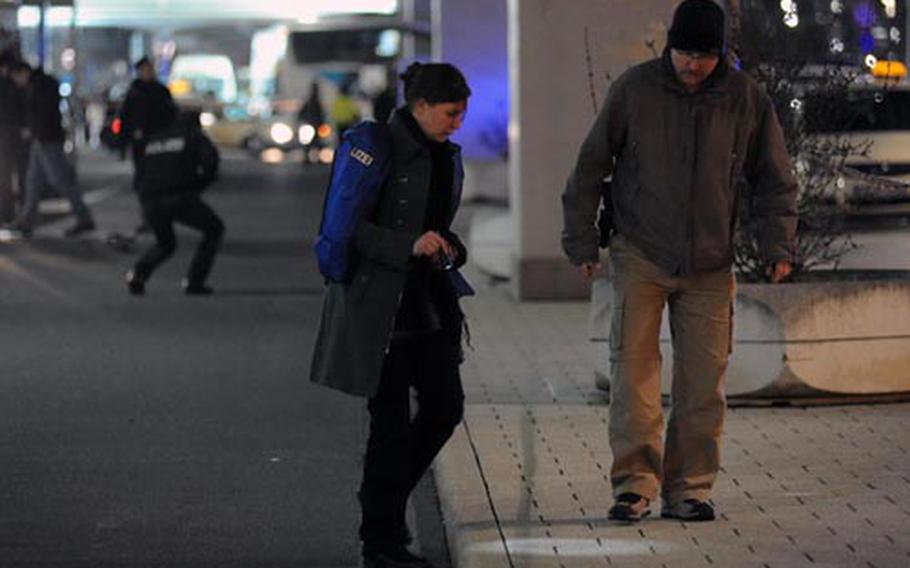
German police crime scene investigators search for clues after the shooting of four Americans at Frankfurt International Airport on March 2, 2011. (Michael Abrams/Stars and Stripes)
FRANKFURT, Germany — The bullets that killed two U.S. airmen and injured two others in an airport shooting spree last March at Frankfurt Airport came from all over the world: the U.S., Brazil, the Czech Republic, Germany and Italy.
Lead fragments of the shells examined at a crime lab in Wiesbaden came from one airman’s hip, and another airman’s head. Other shells had been taken from the shooter’s backpack and from all over the Air Force bus — the floor, the seats, the dashboard — which servicemembers were boarding when Arid Uka started firing.
As the crime lab report was read into evidence Wednesday at Uka’s third court appearance in connection with the March 2 killings, a judge asked Uka why the bullets were so varied.
“I don’t know,” said Uka, a 21-year-old Kosovo Albanian who grew up in Frankfurt. “I didn’t notice that they were different.”
The bullets’ difference is what put an end to the shooting spree, Uka’s defense lawyer, Jens Joerg Hoffmann said after the hearing. “That’s why the gun jammed,” he said.
Uka is charged with two counts of murder in the killing of Senior Airman Nicholas Alden, 25, and Airman 1st Class Zachary Cuddeback, 21. He is also charged with three counts of attempted murder. Two other airmen, Staff Sgt. Kristoffer Schneider and Senior Airman Edgar Veguilla, were wounded. Prosecutors say the gun jammed when Uka aimed it at a third airman.
Cuddeback was the bus driver, stationed at Ramstein Air Base. The rest had arrived from RAF Lakenheath in the United Kingdom getting ready to deploy to Afghanistan.
Uka, who worked at an airport post office and was arrested at the airport after the shootings with the gun in his backpack, confessed to the killings during his first court appearance. He said he was influenced by jihadist propaganda on the Internet.
He said he wanted to prevent American servicemembers from going to Afghanistan, where he said he believed they would rape Muslim girls.
But after Wednesday’s hearing, two lawyers representing the families of the slain and wounded airmen, as German law provides, said they were not convinced Uka had been truthful in his courtroom admission.
“I think it was not religion,” said Marcus Traut, who is representing Schneider, Veguilla and the third airman who was not physically injured but was traumatized when the gun was pointed at him and failed to fire.
“It’s not easy to understand this cruel crime because when you look at Mr. Uka, he’s a boy,” Traut said.
“For my clients, it’s hard for them to understand why the others died and they did not,” Traut said. “The families and the victims, their mothers and fathers — they have to understand why their sons were killed.”
Traut said he suspects that Uka’s expressed religious motive was a tactical move to persuade the court to convict him of manslaughter instead of murder. Manslaughter in Germany carries a maximum sentence of 15 years, Traut said, with eligibility for parole after three years.
By contrast, a murder conviction can bring a life sentence, with parole eligibility after 15 years.
During the hearing, Traut asked Uka if he were “still religious.”
“I believe in God,” Uka said. “I pray.”
The lawyer asked whether Uka’s religion allowed killing people. Only in self-defense, Uka said, adding that what he did was not allowed.
Uka said his actions came after viewing “Lies that I watched that demonized the West.”
Schneider is expected to testify on video from the U.S. because he remains too unwell to travel, Traut said. He has undergone repeated surgeries, including a recent operation in which a metal plate was temporarily removed from his skull. “He has to wear a helmet, actually,” Traut said.
Schneider was also blinded in one eye, his lawyer said.
Also discussed at Wednesday’s hearing was the gun that Uka, who had no criminal history, used in the shootings. It was a 9 mm pistol made in Argentina, a crime lab report said, which had not been used in a previous crime.
But where Uka got the pistol has not been entered into evidence. Uka declined to say where he got the gun in his court confession statement, but his lawyer said Argentine-made guns are widely available in Eastern Europe.
Authorities believe that “he got it from his brother,” said Marcus Steffel, the lawyer representing the Cuddeback and Alden familes.
Prosecutors have said Uka watched a video on the Internet that purported to show American soldiers raping a teenage Muslim girl, but that what he watched was a scene from the movie “Redacted,” based on the rape and murder of an Iraqi girl by U.S. troops in 2006.
German authorities say Uka acted alone.
His trial is to continue intermittently through January. U.S. airmen are among witnesses expected to testify starting later this month.
Stars and Stripes reporter Michael Abrams contributed to this report.